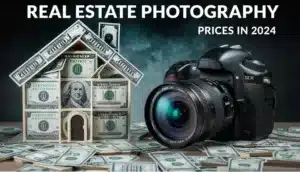Table of Contents
Real Estate Photography: Blending Art and Science
Quality photography is a must for real estate agents and home sellers alike. While phone cameras have improved, they still can’t compare to the results a professional real estate photographer delivers. The best real estate images blend creative talent with technical expertise to showcase a home in the perfect light.
The Creative Process
Real estate photography sits at the intersection of documentation and fine art. Photographers need the technical chops to capture the details and an artistic eye to convey a mood and draw out a property’s finest features. Great real estate photos should tell a story about the home. We want buyers to look at the photos and imagine their lives unfolding there.
Some Key Artistic Considerations Include:
Lighting:
- Photographers combine natural light from windows with external flashes and rigs. Adjusting for room size, wall color, and time of day makes the lighting flattering. Softer natural light suits living spaces, while dramatic artificial lighting accentuates exteriors.
Composition:
- Wide-angle lenses pull in more of the surroundings in each frame. Photographers determine the best vantage points, orientation, and framing to highlight assets like high ceilings, oversized windows, or architectural details. Creative framing directs eyes to standout qualities.
Color and Contrast:
- Post-processing refinements enhance visual pop. Cooling warm hues or upping contrast between walls/floors and furnishings makes them stand out more. Vibrant, balanced color creates a welcoming yet realistic ambiance.
Staging:
- In collaboration with stagers or staging themselves, photographers arrange furniture, decor, artwork, and props to complete the look. Details like shoes by the door or fresh flowers on the dining table inject a lifestyle personality and help buyers envision living in the space.
Technical Skills & Gear
Real estate photography also requires technical know-how. Top photographers utilize specialized equipment and continually hone must-have abilities:
Gear:
- Lenses:
- Wide-Angle Lenses: These lenses have a shorter focal length, allowing for a wider field of view. They are essential for capturing small spaces and making them appear larger or for capturing the breadth of larger spaces.
- Tilt-Shift Lenses: Tilt-shift lenses control perspective and focus in a way that standard lenses do not. They can correct distortions such as the converging parallel lines, which is common when photographing tall buildings or interiors. This makes them invaluable for creating more professional and aesthetically pleasing architectural and real estate photographs.
- Specialty Lenses: Lenses like fisheye lenses or macro lenses can be used creatively in real estate photography to emphasize unique features of a property or to create a unique perspective.

2. Tripods
- Tripods provide a stable platform for the camera, ensuring sharp images are free from camera shake, which is especially important in low light conditions or when using slow shutter speeds. In HDR photography, having a stable platform is crucial as it involves blending multiple images taken at different exposures (more on that below). Any movement between shots can result in a misalignment during the blending process. Moreover, tripods allow for precise framing and easy adjustment between shots, making them indispensable for creating panoramas or other composite images
3. Off-Camera Flashes
- Off-camera flash provides the flexibility to control the direction and quality of light, which is crucial for creating well-lit and visually appealing real estate photographs. By moving the flash off the camera, photographers can avoid flat lighting and harsh shadows, creating a more natural and flattering light that enhances the ambiance and details of the property.
4. Upgraded Camera Bodies and Lenses:
- Upgraded camera bodies usually have enhanced sensor technology that provides better low-light performance, higher resolution, and improved dynamic Range. All these features are crucial for capturing high-quality real estate photographs. On the other hand, upgraded lenses offer better optical quality, sharper images, and faster autofocus, which can save time during a shoot. The combination of an upgraded camera body and lenses allows for capturing images with better clarity, color accuracy, and detail which are crucial for making real estate listings look their best.
Property Analysis:
- Photographers tour homes to map out shots, spot issues like poor existing light, and capitalize on assets like a scenic landscape. Architectural knowledge helps capture spacious layouts accurately.
Shooting Technique:
- Use proper camera settings, perspective, framing, and more to showcase functionality and flow. Window adjustments make inside and outside lighting cohesive. Consistency creates a unified set.
Post-Processing:

Technical Skills and Blending Techniques
Exposure Blending:
- This technique involves capturing multiple images at different exposures and blending them to create a final image with balanced lighting and optimal detail. It accurately represents a property’s lighting and details, capturing the full range of tones and colors in a scene without any part being over or underexposed. This results in more attractive images to potential buyers and can help generate more interest in a property.
High Dynamic Range (HDR) Blending:
- A popular technique for creating high-quality and captivating real estate photographs. This technique often requires the expertise of professionals to bring a realistic touch to real estate photographs.
Understanding HDR Blending
- Dynamic Range refers to the ratio between the maximum and minimum measurable light intensities (white and black, respectively). Dynamic Range measures the range of light levels a camera can capture in photography. Real-world scenes often have a wider dynamic range than a camera can capture in a single exposure.
2. High Dynamic Range (HDR): HDR is a technique used to capture a scene as visualized by the human eye, with all the shadows and highlights, despite the camera’s limitations.
How HDR Blending Works
- Multiple Exposures: HDR blending starts with capturing multiple photographs of the same scene at different exposure levels – typically, one correctly exposed, one underexposed (to capture details in highlights), and one overexposed (to capture details in shadows).
2. Combining Exposures: These exposures are combined into a single image using specialized software such as Adobe’s LightRoom. The software takes the best-exposed parts of each image and merges them into one photo that showcases a broader range of light and color.
3. Tone-Mapping: Once the exposures are blended, a process called tone-mapping is applied to convert the high dynamic range image into a lower dynamic range (LDR) image that can be displayed or printed on standard screens.
HDR Blending in Real Estate Photography:
- Overcoming Lighting Challenges: Real estate photography often involves shooting interiors with varying light conditions, such as bright daylight coming through windows while the rest of the room remains darker. HDR helps in balancing these lighting extremes to produce a well-exposed image.
2. Showcasing Details: HDR blending allows for showcasing details in the bright and dark areas of a property, providing a more accurate and appealing depiction of spaces. This is crucial for online listings where potential buyers decide to visit based on the images seen.
3. Professional Appeal: HDR images have a professional appeal that helps real estate listings stand out in a competitive market. They provide a more realistic or sometimes enhanced view of properties, making listings more attractive to potential buyers.
4. Cost and Time Efficiency: HDR photography can be more cost-effective and less time-consuming than setting up artificial lighting to balance the exposure in a scene.
5. Technological Advancements: With the advent of more advanced HDR software and camera technology, real estate photographers can effortlessly create HDR images, making this technique a staple in real estate photography.
Interior Lighting and Managing Mixed Lighting:
- The purpose of interior lighting in real estate photography is to bring out detail, balance the overall lighting effect, prevent distracting dark spots, and emphasize the key parts of the scene. Direct on-camera flash or bounce on-camera flash can fill in a scene. Multi-flash wireless setups or light-painting techniques can also be employed for styled lighting. Managing mixed lighting is crucial when indoor lighting is combined with ambient outdoor lighting. Selective color adjustments in post-processing software like Lightroom or Photoshop can help neutralize unwanted color casts.
Post Processing:
- Post-processing is an essential step that enhances the visual appeal of real estate photos. Color correction, one of the basic and essential steps in real estate photo editing, can be performed using tools like Lightroom and Photoshop.
The Sales Power of Quality Photos
Investing in professional real estate photography delivers tangible ROI in the sales process. Listings with high-caliber photography gain advantages:
- 61% more online views versus listings without professional photos
- Up to 11% higher sales price compared to listings without pro photos
- There is an average of 5 fewer days on the market than listings lacking professional photography
When technical prowess and creative vision intersect in the hands of a seasoned real estate photographer, visual storytelling elevates a listing and sells the property faster. Real estate photos should inspire emotional connections and help buyers envision the property as their future home, not just another house on the market.
Real estate photography powered by artistry and technique helps agents market listings alluringly and helps sellers present homes in the best possible light. Blending imaginative composition and lighting with technical mastery results in photos that attract more buyers more quickly. Investing in professional real estate photography delivers a definitive visual edge.





